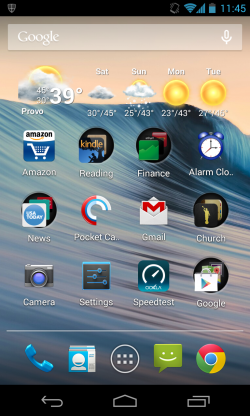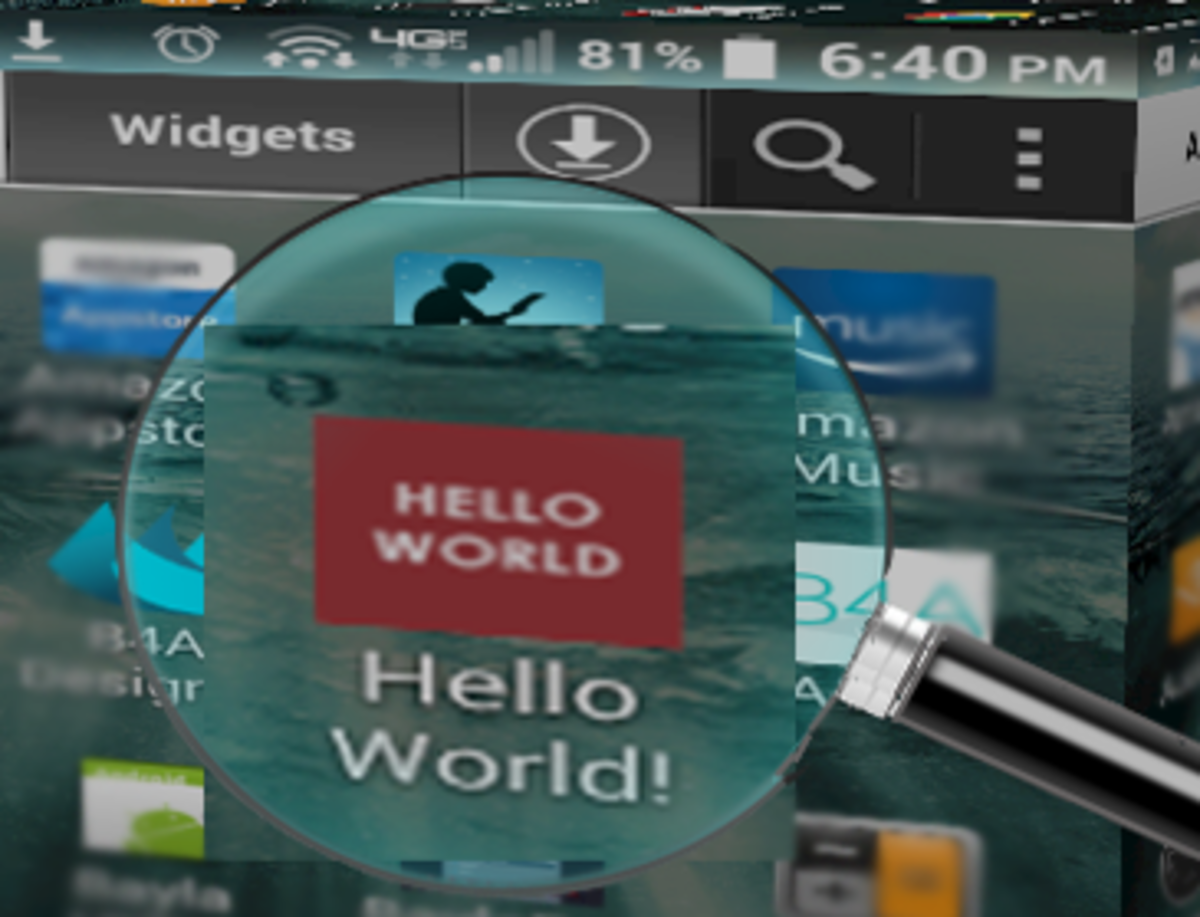5 Basic Features Missing in "Pure" Android

From Dumb to Smart
My first smartphone was a Samsung Galaxy SII from T-Mobile. Before that I used many dumb phones, such as the Nokia 8210, Motorola Razr V3, and BlackBerry Pearl Flip 8220. Transitioning from dumb to smart in the world of mobile phones has enhanced and enlightened my life more than I care to admit.
I currently am using a Google Nexus 4 (manufactured by LG) which is running Android 4.4 (KitKat). In the Android and smartphone world, this particular flavor of Android that comes on Nexus (as well as "Google Play Edition") devices is referred to as "pure" or "vanilla" Android. It gets this moniker due to the fact that it has not been tampered with by a carrier and/or manufacturer with things like bloatware or customized launchers.
Having a pure Android experience free of bloatware was liberating. However, there are some basic features missing that have become annoying and in some cases downright debilitating in the first month or so of using this phone. I'll highlight the 5 most glaring of these features below, then let you decide which is the most offensive in the poll at the bottom.
1. No battery percentage indicator in the status bar
I didn't realize that this was a special feature added by carriers/manufacturers until I started using my "pure" Android Nexus 4. I couldn't even remember the last time I had used a phone that didn't display the remaining battery percentage in the status bar. This seems like such a basic feature that I refused to believe it was true for the first several hours I used my Nexus 4. I dug through the settings of my phone as well as all over the web in search of a toggle to display battery percentage, but alas, I came up empty handed.
Another possible justification I came up with in my mind was that there was a patent preventing Google from including this in Android. However, I can't imagine that Samsung and others could include it in their phones and would be able to get away with it while Google was forced to remain in the mobile technology dark ages.
While searching high and low online for answers, I came across various forum threads with other Android enthusiasts clamoring for this to be included in future releases of Android. During this search, I found an app that does what I want called Battery Overlay Percent, although it's a bit rough around the edges and doesn't always work perfectly.
There also appears to be a workaround in the latest version of Android (4.4 KitKat), as described in this article. However, it requires a bit of tinkering with advanced settings and the resulting percentage seems to blend in with the stock battery indicator, making it a less than ideal solution. The fact that there is a way to turn on this option in the latest version of Android hopefully is evidence that the days of this oversight are numbered.
2. No option to wake screen when notifications are received
While researching this issue to see if I could find a way to have my screen light up when I received a text or notification, I found that most people that cared enough about this to chime in were either strongly for or strongly against this feature.
Those in favor of this option (myself included) seem to want to be alerted of a new text or notification immediately after it arrives. Personally, I think I always turn on my phone when I hear my phone buzz as a notification comes in, no matter how many silly Facebook requests I've received since the last incoming text.
Those against, on the other hand, seem to be fed up with their screens flashing brightly at all hours of the night. With all the huge, bright, high definition screens we're seeing on mobile phones these days, it's not surprising that people complain about this, especially considering all the apps fighting for your attention by sending notifications out. However, I feel that putting your phone face down while you don't want to be disturbed by that bright screen (such as when you're sleeping) is a simple workaround, whereas getting the screen to light up (if you're in other camp) seems to be impossible. *UPDATE: I've found a workaround since writing this lens. There are apps available in the Google Play Store which include the ability to wake up your phone when a text message arrives (Handcent SMS, for one). However, II still believe Google should include this in stock Android.
Regardless of which camp you fall in, I feel that Google could include an option to allow each user to choose when they'd like their screen to light up. This seems like a reasonable request to me.
3. Phone dialer can't search contacts while dialing
I remember dialing "POPCORN" on our land line phone when I was a kid to check the time, especially when daylight savings time had recently started or ended and we were trying to settle a dispute about what the actual time was. For those of you too young to remember those days or otherwise unaware of the calling popcorn tactic, to dial popcorn, you would dial the number that corresponded to each letter in the word popcorn on your phone, then you would get a robotic woman's voice telling you the current time every 30 seconds or so.
Since this concept is at least a couple of decades old, it's shocking to me that this is missing in the Phone app on my phone released in late 2012 with Google's operating system. I realize that if I wanted to call a friend named "John Smith" there are many other options, but I still find myself trying to type 5-6-4-6... (J-O-H-N...) in the dialer screen of the Phone app since my previous ("impure" Android) phone was able to do this.
The dialer in the Phone app of the latest version of Android (4.4 KitKat) incorporates a phonebook that automatically searches for local businesses as you type numbers. However, I haven't seen any evidence that it also includes the ability to type a contacts' name in the dialer as a method to look them up.
UPDATE: After receiving the OTA update for Android 4.4 (KitKat) on my Nexus 4 on 11/25/2013, I actually found that this feature is now included in the update. However, since it could be weeks or months until carriers release the update to KitKat (if ever), I feel this is still a relevant oversight.
4. No quick reply for SMS messaging
There is a plethora of SMS messaging apps out there you can use in place of the standard Android messaging app. Each one features its own unique set of customizable features and themes. One such feature, which I found especially useful is called "quick reply." This feature shows a pop up screen with new messages on your screen when it arrives and allows you type and send a response in the same pop up window.
I found that this feature saved me quite a bit of time and frustration when trying to respond to a text message. Instead of pushing the power/lock button, swiping across the screen to unlock my phone, launching the messaging app, selecting the new message, and then finally being able to type my response, this feature allowed me to begin typing my response after a single click.
This "quick reply" idea actually seems like the exact kind of thing that Google would come up with. I am disappointed that the default messaging app does not include this option since I try to avoid installing apps that do something that one of Google's apps is intended to do. It would be great if Google's messaging app did for SMS messaging what Gmail and Chrome did for email and web browsing - create a simplified and streamlined experience that made a once frustrating experience user-friendly.
5. Poor sound controls
If you own a smartphone, you more than likely use it to listen to music and other audio. Gone are the days in which we are forced to lug around a dedicated music player in addition to a mobile phone. Part of what makes our phones smart is that they include this functionality.
I especially enjoy listening to podcasts on my way to and from work. Since I don't have a stereo in my car, I just set my phone in the center console with the speaker on full blast to listen to my podcasts. The speaker on my Nexus 4 is amazingly loud and this works out great. Until, that is, I'm in a different app while my audio is playing and I want to decrease the volume of the speakers. My phone is not smart enough in this situation to know that I want the audio blasting out of my speakers to be decreased. This is understandable (I don't expect it to read my mind - at least not for a few more years), but the options to control the sound are under (or over?) par.
It would be fantastic if pure Android included an expanded volume control pop up window when I adjust the volume with the volume hardware buttons on my phone. This expanded volume control would allow me to adjust the three categories of volumes already included in the volume settings (music/media, ringtone/notifications, and alarms) with three different volume sliders in the pop up. In addition, it could allow me to toggle vibration on or off by pressing the icons next to each. Again, this doesn't seem like a terribly advanced feature or something unreasonable to ask for.
Conclusion
While there are many apps available that can do some of the things I've mentioned here, it still surprises me that Google hasn't included these in their mobile operating system yet. For a company known for their innovative products, such basic features as these seem like major oversights.
So, which of these missing features do you deem the most egregious oversight? Cast your vote in the poll below to make your voice heard.
Note: I wrote this a few days before I received the OTA update for Android 4.4 (KitKat) on my Nexus 4. I made some minor updates after receiving the 4.4 update, but if I missed anything, let me know in the comments.
Which of the oversights mentioned in this article is the most critical to you?
Nexus 5 with Android 4.4 KitKat
The Nexus 5 is the latest flagship Google phone running "pure Android." One of the most attractive things about this and other Nexus devices is that it comes factory unlocked and does not require one of those pesky contracts that makes you a slave to your carrier for 2 years. Its specs are also impressive, especially considering its price ($349 for 16GB of storage or $399 for 32GB):
- Weight: 4.8 oz
- Thickness: 8.59 mm
- Snapdragon(TM) 800, 2.26GHz processor
- 4G/LTE and Dualband Wi-Fi
- Ships with Android 4.4, KitKat
- Wireless charging
Check out the YouTube video by Android Central below for more info on this awesome device.




